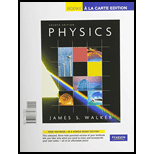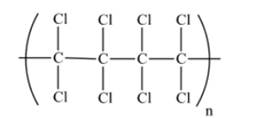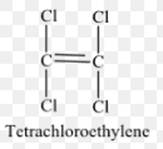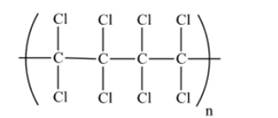
(a)
Interpretation:
A portion of the polymer made from tetrachloroethylene needs to be drawn.
Concept Introduction:
A polymer is a long chain consists of large number of monomer units. In a polymer, the monomers are linked to each other in a continuous or repetitive manner. These monomer units are linked to each other either through the formation of peptide linkage,glycosidic linkage or by removal of any moiety such as a water molecule.Polyvinyl chloride, Bakelite and polystyrene are some of the examples of the
(a)
Answer to Problem 1QAP
A portion of polymer made from tetrachloroethylene is as follows:

Explanation of Solution
Tetrachloroethylene polymer consists of number of monomer unit of 1,1,2,2-tetrachloroethylene.
The structure of tetrachloroethylene or monomer unit of the polymer is as follows:

The polymer is formed after breaking of C-C double bonds, the two terminal carbon atoms of 1 tetrachloroethylene unit form bond with 2 terminal carbons of two other tetrachloroethyleneunits. To form a polymer, n numbers of such tetrachloroethyleneunits combined in the same way.
A portion of this polymer is shown as follows:

(b)
Interpretation:
The molar mass of the polymer needs to be calculated if it contains
Concept Introduction:
A polymer is a long chain consists of large number of monomer units. In a polymer, the monomers are linked to each other in a continuous or repetitive manner. These monomer units are linked to each other either through the formation of peptide linkage, glycosidic linkage or by removal of any moiety such as a water molecule. Polyvinyl chloride, Bakelite and polystyrene are some of the examples of the polymers.
Tetrachloroethylene polymer consists of number of monomer unit of 1,1,2,2-tetrachloroethylene.
(b)
Answer to Problem 1QAP
The molar mass of complete polymer is
Explanation of Solution
Molar mass of 1 monomer unit of 1,1,2,2-tetrachloroethylene is 168 g /mol. This is mass of 1 molecule of the 1,1,2,2-tetrachloroethylene.
If the polymer contains
Thus, molar mass of complete polymer is
(c)
Interpretation:
The mass percent of C and Cl in the polymer needs to be determined.
Concept Introduction:
Mass percent of an atom present in the sample can be determined by dividing mass of atom present in the monomer to the overall mass of the monomer unit and multiplying the overall result with 100%.
For example, the mass percent of x g of an atom present in the y g of monomer unit can be determined as:
(c)
Answer to Problem 1QAP
Mass percent of C in polymer is 14.28 %.
Mass percent of Cl in polymer is 83.33 %.
Explanation of Solution
The molar mass of the 1 tetrachloroethylene unit is 168 g/mol.
There are 2 C atoms in a monomer unit of tetrachloroethylene.
Now, molar mass of C atom in a monomer will be:
Putting the values,
Thus, mass percent of C in polymer is 14.28 %.
The number of Cl atoms in the monomer unit of tetrachloroethylene is 4.
Molar mass of Cl in a monomer will be:
Mass percent of Cl can be calculated as follows:
Putting the values,
Thus, mass percent of Cl in the polymer is 83.33 %
Want to see more full solutions like this?
Chapter 23 Solutions
Student Solutions Manual For Masterton/hurley's Chemistry: Principles And Reactions, 8th
- The product on the right-hand side of this reaction can be prepared from two organic reactants, under the conditions shown above and below the arrow. Draw 1 and 2 below, in any arrangement you like. 1+2 NaBH₂CN H+ N Click and drag to start drawing a structure. X $arrow_forwardExplain what is the maximum absorbance of in which caffeine absorbs?arrow_forwardExplain reasons as to why the amount of caffeine extracted from both a singular extraction (5ml Mountain Dew) and a multiple extraction (2 x 5.0ml Mountain Dew) were severely high when compared to coca-cola?arrow_forward
- Protecting Groups and Carbonyls 6) The synthesis generates allethrolone that exhibits high insect toxicity but low mammalian toxicity. They are used in pet shampoo, human lice shampoo, and industrial sprays for insects and mosquitos. Propose detailed mechanistic steps to generate the allethrolone label the different types of reagents (Grignard, acid/base protonation, acid/base deprotonation, reduction, oxidation, witting, aldol condensation, Robinson annulation, etc.) III + VI HS HS H+ CH,CH,Li III I II IV CI + P(Ph)3 V ༼ Hint: no strong base added VI S VII IX HO VIII -MgBr HgCl2,HgO HO. isomerization aqeuous solution H,SO, ༽༽༤༽༽ X MeOH Hint: enhances selectivity for reaction at the S X ☑arrow_forwardDraw the complete mechanism for the acid-catalyzed hydration of this alkene. esc 田 Explanation Check 1 888 Q A slock Add/Remove step Q F4 F5 F6 A བྲA F7 $ % 5 @ 4 2 3 & 6 87 Click and drag to start drawing a structure. © 2025 McGraw Hill LLC. All Rights Reserved. Terms of Use | Privacy Ce W E R T Y U S D LL G H IK DD 요 F8 F9 F10 F1 * ( 8 9 0 O P J K L Z X C V B N M H He commandarrow_forwardExplanation Check F1 H₂O H₂ Pd 1) MCPBA 2) H3O+ 1) Hg(OAc)2, H₂O 2) NaBH4 OH CI OH OH OH hydration halohydrin formation addition halogenation hydrogenation inhalation hydrogenation hydration ☐ halohydrin formation addition halogenation formation chelation hydrogenation halohydrin formation substitution hydration halogenation addition Ohalohydrin formation subtraction halogenation addition hydrogenation hydration F2 80 F3 σ F4 F5 F6 1 ! 2 # 3 $ 4 % 05 Q W & Å © 2025 McGraw Hill LLC. All Rights Reserved. F7 F8 ( 6 7 8 9 LU E R T Y U A F9arrow_forward
- Show the mechanism steps to obtain the lowerenergy intermediate: *see imagearrow_forwardSoap is made by the previous reaction *see image. The main difference between one soap and another soap isthe length (number of carbons) of the carboxylic acid. However, if a soap irritates your skin, they mostlikely used too much lye.Detergents have the same chemical structure as soaps except for the functional group. Detergentshave sulfate (R-SO4H) and phosphate (R-PO4H2) functional groups. Draw the above carboxylic acidcarbon chain but as the two variants of detergents. *see imagearrow_forwardWhat are the reactions or reagents used? *see imagearrow_forward
 Introductory Chemistry: An Active Learning Approa...ChemistryISBN:9781305079250Author:Mark S. Cracolice, Ed PetersPublisher:Cengage Learning
Introductory Chemistry: An Active Learning Approa...ChemistryISBN:9781305079250Author:Mark S. Cracolice, Ed PetersPublisher:Cengage Learning Chemistry: The Molecular ScienceChemistryISBN:9781285199047Author:John W. Moore, Conrad L. StanitskiPublisher:Cengage Learning
Chemistry: The Molecular ScienceChemistryISBN:9781285199047Author:John W. Moore, Conrad L. StanitskiPublisher:Cengage Learning Chemistry: Principles and ReactionsChemistryISBN:9781305079373Author:William L. Masterton, Cecile N. HurleyPublisher:Cengage Learning
Chemistry: Principles and ReactionsChemistryISBN:9781305079373Author:William L. Masterton, Cecile N. HurleyPublisher:Cengage Learning ChemistryChemistryISBN:9781305957404Author:Steven S. Zumdahl, Susan A. Zumdahl, Donald J. DeCostePublisher:Cengage Learning
ChemistryChemistryISBN:9781305957404Author:Steven S. Zumdahl, Susan A. Zumdahl, Donald J. DeCostePublisher:Cengage Learning Chemistry: An Atoms First ApproachChemistryISBN:9781305079243Author:Steven S. Zumdahl, Susan A. ZumdahlPublisher:Cengage Learning
Chemistry: An Atoms First ApproachChemistryISBN:9781305079243Author:Steven S. Zumdahl, Susan A. ZumdahlPublisher:Cengage Learning





